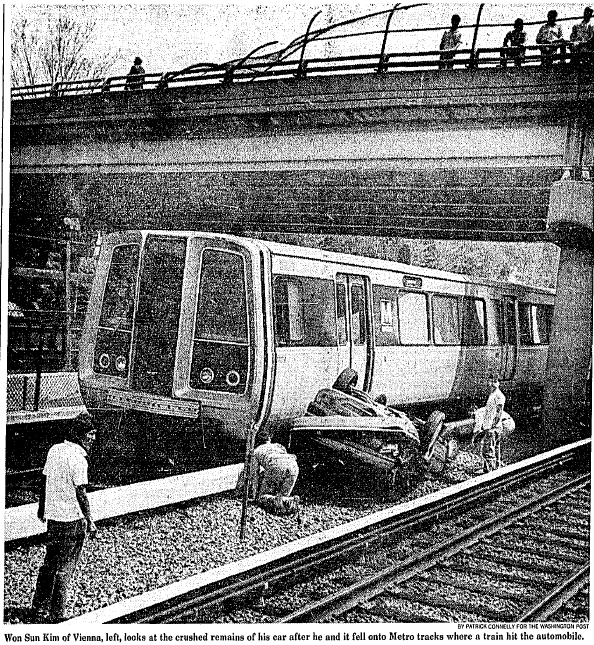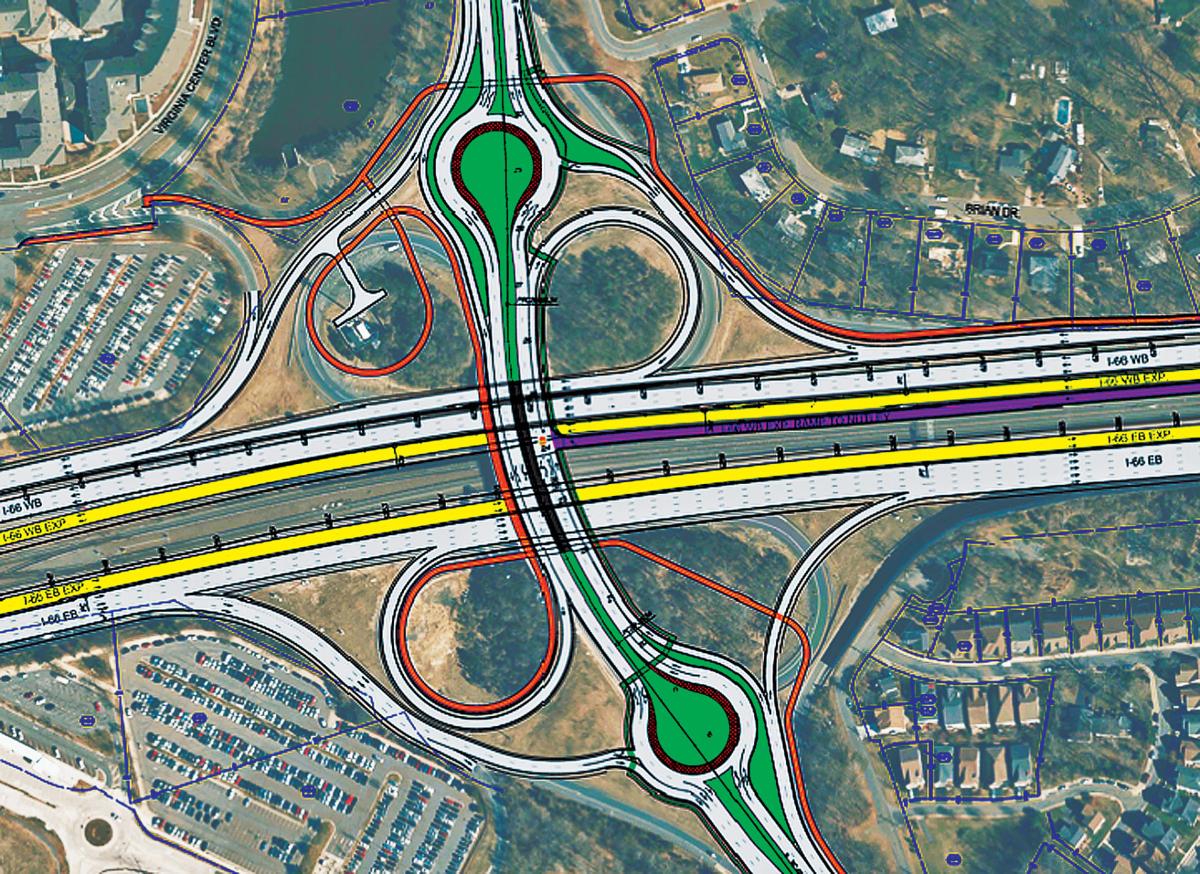
As the “Transform 66” project is planning to replace many bridges across I-66, it is worth remembering a heart stopping incident that happened 30 years ago this week. A driver somehow lost control on Cedar Lane, jumped over the sidewalk and low “guardrail,” then tumbled onto the Orange Line tracks below….just as an outbound train was only seconds away. Miraculously, the worst injury was fairly minor and everyone walked away.
Yet 30 years after this Spring 1989 crash, the same design flaws still exist on the Cedar Lane overpass. There is no protection against cars from jumping up on the curved sidewalk. Worse, the guardrail is proven to be insufficient at keeping even compact cars (e.g. a 1989 Ford Escort) from dropping off the bridge. The low guardrail remains a risk for pedestrians and bicycle riders too, who often are forced to use the narrow sidewalk because there is no room to avoid vehicles and impatient drivers on Cedar Lane. The very short railing is too low to protect someone walking from accidentally falling over if tripped or changes direction suddenly while riding a bicycle. In 2017, a child on a bicycle lost his life when he fell at this very spot onto I-66. Even since then, VDOT made no safety improvements to the sidewalk or guardrail.
WMATA (Metro) required a chain link fence in the middle of the bridge to be installed when the Orange Line extension to Vienna opened in the mid-1980s. It protects only the Metro tracks from mischief and jumpers; the portion of the bridge over freeway lanes has no fencing, only the low guardrail. There still is no fence where the 2017 tragedy happened. Why not, VDOT? Hoping for the best until the entire bridge is replaced?
When I-66 Express Mobility Partners replaces Cedar Lane and its peer bridges, what safety features for pedestrians and vehicles can we expect? Will there be shoulders wide enough for bicycles? Will railings be higher than a child’s waist?
Car Falls 23 Feet Into Path of Metro Train
From the Washington Post Newspaper Archives:
A car crashed through a guardrail on an Interstate 66-Metro Orange Line overpass, fell to the tracks, and was struck by an oncoming Metro train yesterday afternoon, disrupting train service and clogging the expressway in both directions for more than an hour.
The driver of the 1989 Ford Escort, Won Sun Kim, 40, of Vienna, escaped from the car before the six-train train hit it, and none of the estimated 40 passengers aboard the Metro train was seriously injured. A rush-hour train easily could have been carrying as many as 1,000 people.
The 12:06 p.m. accident was unusual in every way. An ambulance crew heading across the overpass on another call witnessed the accident and phoned it in. A construction crane driver happened to be on I-66 near the accident site, so authorities were able to clear the car off the tracks within an hour.
Furthermore, the operator of the train, whom Metro officials would not identify, pushed the emergency brake button soon enough to slow the train to less than 5 miles an hour before it hit the car a glancing blow.
The overpass, which carries Cedar Lane, is about halfway between the Dunn Loring and Vienna Metro stations at a point where trains normally travel 55 mph. At that speed, it takes 18 seconds for the train to stop after the operator hits the brakes.
Fairfax County police Capt. Robert A. Carlisle said that Kim “should certainly feel that someone was on his side today. If you would have related this accident account to me, I would have told you the guy would have been killed.
Kim, who does not speak English, was treated at Fairfax Hospital and released. He said through his brother that there was a problem with the steering of the vehicle; police are checking the automobile for defects. The doctor who treated him, Michael J. Boyko, said Kim suffered only a cut to his left elbow. Boyko said Kim was not intoxicated.
Rail service to the Dunn Loring and Vienna stations, the last two Virginia stations on the Orange Line, was halted from about noon to 2:30 p.m. while Metro officials moved the train and inspected the tracks and police completed their investigation.
Traffic on I-66, which is usually congested, was halted for several minutes immediately after the accident; eventually a few lanes were cleared in each direction until authorities opened the highway completely about 1:15 p.m.
Kim “was extremely lucky. He could have landed on I-66,” said John J. Flynn, Metro’s deputy assistant general manager for rail.
The posted speed limit along Cedar Lane is 35 mph, and there is a sign before the overpass warning drivers to slow down. Police said Kim’s car, traveling south, possibly at high speed, may have crossed a double yellow line in the northbound lane in a possible attempt to pass another vehicle. The car spun out of control, crossed the southbound lane and went through the guardrail. No charges have been filed.
Virginia highway officials said that the distance from the roadbed to the highway below is 23 feet, 8 inches.

Accounts of the accident provided by police, fire and Metro officials were conflicting.
Police said that the vehicle landed on the center of the tracks and bounced over to the 750-volt third rail, popping the cover off the rail that supplies electricity to the train. About 15 seconds later, the train struck the car.
Metro officials said that the car landed between the eastbound and westbound tracks, extended slightly onto the westbound tracks where the train was approaching. The train only grazed the car, Metro officials said, stopping about 10 feet from it. They said the impact of the car hitting hte tracks cut power to the third rail.
Flynn, the Metro official, said that the car triggered Metro’s intrusion alarm, which sends a signal to central control.
Metro officials said that the train was just scratched. The car also caused minor damage to the tracks.
Passengers on the train waited at the accident scene for about an hour before a bus arrived to take them to the Vienna station.
In explaining why the train driver would not be identified or made available for interviews, Metro spokeswoman Beverly Silverberg said “It is public affairs policy at [Metro] to not release the names of employees involved in incidents unless they are charged or cited for violations of law or become defendants in lawsuits related to the incident. This policy is designed to protect employees’ privacy.”
—
The Washington Post: Stephen C Fehr; Nell Henderson
Staff writers Peter Baker and Dana Priest contributed to this report.

/cloudfront-us-east-1.images.arcpublishing.com/pmn/7GWQZ5WEXRHWTCBUYWN5RX5GFU.jpg)



